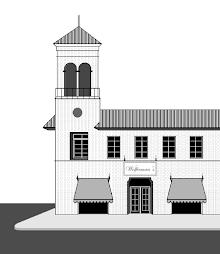From humble beginnings in the Natural State, Wal-Mart has grown into its current position as the world's largest corporation and retailer. Wal-Mart founder Samuel Walton opened his first (franchised) Ben Franklin variety store, in Newport, Arkansas, in 1945. He established his own Walton's 5 & 10 store, in Bentonville, Arkansas, in 1950.
This store was eventually expanded and renamed as a Walton's Family Center. The Family Center concept gave way to the first Wal-Mart Discount City, which opened, in Rogers, Arkansas, on July 2, 1962. By the end of the year, there was the one Discount City, in Rogers. In 1972, there were fifty-one stores. The count in 1982 was 491, with 1,720 units in operation in 1992.
Discount City units encompassed between 30,000 and 60,000 square feet, with the average store covering 42,000. The first trans-state extension of the Wal-Mart enterprise, in 1968, brought new stores in Missouri and Oklahoma. By 1971, Wal-Mart was in Kansas and Louisiana. In 1973, locations opened in Tennessee; in Kentucky and Mississippi, in 1974. The Texas market was first entered in 1975. Michigan and Illinois operations debuted in 1977 with those in Alabama, Georgia, South Carolina and Virginia established in 1982.
By this time, the typical Walmart Discount Store encompassed 105,000 square feet. The first Northeastern United States unit was dedicated, in York, Pennsylvania, in October 1990. Originally centered in the American South and Midwest, Wal-Mart stores were extended from coast-to-coast in 1995. By this time, Wal-Mart's sales had surpassed those of fellow competitors Kmart and Target, making it the most profitable retailer in the nation.
Over the years, various store formats have evolved. The first Hypermart USA unit was dedicated, in Garland, Texas, on December 28, 1987. The Hypermart USA concept combined general merchandise and groceries in a 220,000 square foot structure. Stores included a food court, bank, video arcade, hair salon, pharmacy, vision center and 1-hour photo lab. The Hypermart format was unsuccessful, as its four stores were simply too large. The concept was abandoned in the year 2000.
The Wal-Mart SuperCenter idea was much more successful. The first unit, in Washington, Missouri, welcomed its first shoppers on March 1, 1988. Stores combined general merchandise and groceries and could include a restaurant, hair salon, optical department, garden center, filling station and Tire & Lube Express. The average size of a SuperCenter was 178,000 square feet. As of late 2021, there were over 3,500 stores in forty-nine states, the District of Columbia and Puerto Rico.
In the 2020s, WalMart, Incorporated oversees stores in all of the fifty states, as well as in Canada, Mexico, Central America, Chile, South Africa, the United Kingdom, China and India. Expansions into Germany, South Korea and Japan were not successful and were eventually abandoned. As of late 2023, there were 4,623 WalMart stores in operation in the United States.
WAL-MART-ANCHORED SHOPPING MALLS:
*MANOR EAST MALL, Bryan, TX (1981)
*BISCAYNE MALL, Columbia, MO (1983) [WalMart assumed vacant Montgomery Ward]
*BAMA MALL, Tuscaloosa, Alabama (1987) [WalMart assumed vacant Murphy's Mart-Ames]
*BAMA MALL, Tuscaloosa, Alabama (1987) [WalMart assumed vacant Murphy's Mart-Ames]
TG&Y FAMILY CENTERS
Following the lead of Kresge-Kmart and Woolworth-Woolco, Oklahoma's TG&Y variety stores brought out their version of discount mart on August 30, 1963. Located in UPTOWN CENTER, in Midwest City, Oklahoma, the first TG&Y Family Center covered 26,000 square feet. Included were departments not found in the typical TG&Y 5 & 10, such as sporting goods, cameras-photo development and a snack bar. Moreover, for the first time, installment buying was offered to customers via new Family Center credit cards.
The second Family Center was located in the EDMOND PLAZA CENTER, in Oklahoma City. This store, which encompassed 25,000 square feet, opened for business on May 21, 1964. A third Family Center was dedicated -at OKC's SOUTHERN HILLS CENTER- on June 25, 1964. By year's end, five Family Centers were in business.
TG&Y Stores Company was operating over 200 Family Centers in 1973. Stores now sold building supplies and large home appliances and often included a Rexall pharmacy and freestanding Auto Center. By the late 1970's, there were Family Centers in twenty-three southern, western and mid-western states. Two Family Center formats had been established. The smaller Family Center would cover between 20,000 and 30,000 square feet, with the larger Family Center encompassing between 40,000 and 80,000 square feet.
The 1980s were brutal tears for the TG&Y variety store and Family Center enterprise. The company recorded its first unsuccessful year in 1982, when it sustained a 16 million dollar loss. Part of this could be attributed to the company's introduction of a new store format known as AIM for the best. More upscale than a standard Family Center, the AIM store was devised as an eventual replacement for the Family Center.
The first AIM store opened, in Stillwater Oklahoma, on July 8, 1982. Thirteen stores were built before the unsuccessful format was abandoned, in August 1984. Meanwhile, Family Centers were being shuttered and repurposed. In May 1984, management decided that no new Family Centers would be built. At this time, the TG&Y store count stood at 247 variety stores and 508 Family Centers.
Woolco's demise, in early 1983, was a mixed blessing for TG&Y Stores. There was now opportunity for expansion into areas previously served by Woolco. Unfortunately, this situation was quickly exploited by a rapidly-expanding discount chain from Arkansas.
Assets of the struggling TG&Y Stores Company were acquired by York, Pennsylvania's McCrory Corporation in January 1986. In March, McCrory announced that they would shutter 200 TG&Y stores and convert 500 to a standard variety store format. The final Family Centers went dark in August 1986.
TG&Y FAMILY CENTER-ANCHORED SHOPPING MALLS:
*SHEPHERD MALL, Oklahoma City, Oklahoma (1964)
*KINGSHIGHWAY PLAZA MALL, Sikeston, MO (1970)
*DEVARGAS CENTER, Santa Fe, NM (1973)


